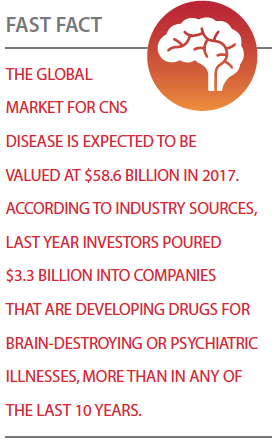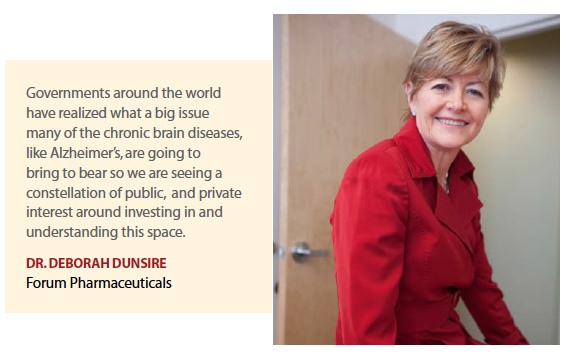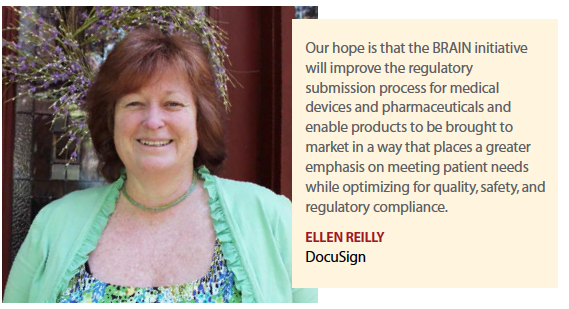In 2013, President Obama launched the Brain Research through Advancing Innovative Neurotechnologies, or BRAIN Initiative, as a large-scale effort to equip researchers with fundamental insights necessary for treating a wide variety of brain disorders such as Alzheimer’s, schizophrenia, autism, epilepsy, and traumatic brain injury. These new tools and this deeper understanding will ultimately catalyze new treatments and cures for devastating brain disorders and diseases that are estimated by the WHO to affect more than 1 billion people worldwide.
 “The human brain is the most complicated biological structure in the known universe," says NIH Director Francis S. Collins, M.D., Ph.D. “We’ve only just scratched the surface in understanding how it works or, unfortunately, doesn’t quite work when disorders and disease occur. This is just the beginning of a 12-year journey and we’re excited to be starting the ride."
“The human brain is the most complicated biological structure in the known universe," says NIH Director Francis S. Collins, M.D., Ph.D. “We’ve only just scratched the surface in understanding how it works or, unfortunately, doesn’t quite work when disorders and disease occur. This is just the beginning of a 12-year journey and we’re excited to be starting the ride."
The global market for CNS disease is expected to be valued at $58.6 billion in 2017. According to industry sources, last year investors poured $3.3 billion into companies that are developing drugs for brain-destroying or psychiatric illnesses, more than in any of the last 10 years.
The Next Moonshot
Recently, the National Institutes of Health announced its second wave of grants to support the goals of the BRAIN Initiative, bringing the NIH investment to $85 million in fiscal year 2015. Sixty-seven new awards, totaling more than $38 million, will go to 131 investigators working at 125 institutions in the United States and eight other countries. These awards expand NIH’s efforts to develop new tools and technologies to understand neural circuit function and capture a dynamic view of the brain in action.
Projects include proposals to develop soft self-driving electrodes, ultrasound methods for measuring brain activity and the use of deep brain stimulation to treat traumatic brain injuries. Last year NIH awarded $46 million to BRAIN Initiative research.
 Planning for the NIH component of the BRAIN initiative is guided by the long-term scientific plan, BRAIN 2025: A Scientific Vision that details seven high priority research areas. The long-term outcomes of the initiative include the ability to: target specific human cell types to develop new therapies for neurological and psychiatric disorders; discover circuit-level anatomical differences between healthy and disordered brains; treat neurological and psychiatric disorders based on knowledge of each patient’s own circuitry and neural activity patterns; discover general principles of neural coding, circuit dynamics, and plasticity; understand neural population dynamics associated with perception, learning, memory, emotion, and action; and gain insight into the neural basis of human language, symbolic reasoning, and consciousness. To accomplish these goals, there are seven guiding principles:
Planning for the NIH component of the BRAIN initiative is guided by the long-term scientific plan, BRAIN 2025: A Scientific Vision that details seven high priority research areas. The long-term outcomes of the initiative include the ability to: target specific human cell types to develop new therapies for neurological and psychiatric disorders; discover circuit-level anatomical differences between healthy and disordered brains; treat neurological and psychiatric disorders based on knowledge of each patient’s own circuitry and neural activity patterns; discover general principles of neural coding, circuit dynamics, and plasticity; understand neural population dynamics associated with perception, learning, memory, emotion, and action; and gain insight into the neural basis of human language, symbolic reasoning, and consciousness. To accomplish these goals, there are seven guiding principles:
1. Pursue human and non-human animal studies in parallel
2. Cross boundaries in interdisciplinary collaborations
3. Integrate spatial and temporal scales
4. Establish platforms for sharing data and tools
5. Validate and disseminate technology
6. Consider ethical implications of neuroscience research
7. Be accountable to NIH, taxpayers, and the scientific community
Some experts say the BRAIN initiative is America’s next moonshot, providing short-term and longer-term benefits of this far-reaching and collaborative program.
“We’re beginning to see the tools that can better image the brain," says Deborah Dunsire, M.D., CEO of Forum Pharmaceuticals. “We’ve had technologies such as MRI machines for a long time, but they can only tell us about the gross structures of the brain; they don’t tell us about the networks underlying brain function. When we think about the brain from the cell to the circuit to the synapses between neurons, to the circuits that those create within the brain, we’re beginning to understand that circuitry better.
The science is advancing in term of both the imaging of the brain and the understanding of what those circuits are actually doing and how they are controlled. This aspect of the science is becoming better understood. We’re at the bottom of the inflection; things are not going to change overnight, but we’re on a path where when we look back a decade from now, we will see that there’s been a tremendous amount of forward movement."
“New advanced optics are enabling scientists to see into the brain at the molecular level like never before," says Victoria Summers, executive VP, engagement strategy and analytics, Saatchi & Saatchi Wellness. “Not only will their learnings help us understand our brains and unlock new possibilities for fighting brain disease, but they will also create optical advances that can be applied to other industries.
I believe deep brain imaging technology will redefine how we see the world, as well as how we see the deepest parts of ourselves."
Creating a Brain Trust
The goal of BRAIN Initiative Public-Private Partnership Program is to facilitate partnerships between clinical investigators and manufacturers of latest-generation stimulating and/or recording devices that are FDA-designated as Class III (invasive, posing significant risk of harm), to conduct clinical research in the area of CNS.
 As part of The BRAIN Initiative, the NIH is interested in reducing barriers to negotiating such partnerships and ensuring that new clinical studies leverage manufacturers’ existing data demonstrating safety and utility of these devices, data that are costly to obtain and pose a substantial barrier to research progress.
As part of The BRAIN Initiative, the NIH is interested in reducing barriers to negotiating such partnerships and ensuring that new clinical studies leverage manufacturers’ existing data demonstrating safety and utility of these devices, data that are costly to obtain and pose a substantial barrier to research progress.
To advance these goals, NIH has signed Memoranda of Understanding (MOUs) with device manufacturers that serve as the basis for this program. Each participating company has provided information on devices and support they are willing to provide to researchers. This information serves as a guide for investigators wishing to pursue specific agreements with manufacturers for submission of research proposals to the NIH. To streamline legal and administrative process for partnerships between manufacturers and academic research institutions, the NIH has created template collaborative research agreements and confidential disclosure agreements that will serve as a common starting point for these partnerships. The templates are based on drafts that received substantial input from clinical researchers, representatives from government agencies, including the FDA, representatives from the medical device industry, from institutional tech-transfer and contracts offices, and from the general public.
“The BRAIN initiative facilitates a new, unprecedented level of collaboration between private entities working to bring new products and the public sector," says Ellen Reilly, VP, life sciences and healthcare, DocuSign. “Our hope is that this initiative will improve the regulatory submission process for medical devices and pharmaceuticals and enable products to be brought to market in a way that places a greater emphasis on meeting patient needs while optimizing for quality, safety, and regulatory compliance. The participation of public or government agencies in each step of the development process with real-time exchange of information has the potential to change the way groundbreaking products get through the submission process."
Ms. Summers notes work being done by the Janelia Research Campus and the University of North Carolina focusing on imaging optics while work at Duke is making strides in the use of flexible silicon electronics.
“The combination of private organizations, such as Janelia, founded by Howard Hughes Medical Institutes, and public universities help to drive healthy competition to drive innovation will someday transform our lives," she says.
Janelia has developed Nobel Prize-winning imaging technologies and new ways of processing scientific data allowing researchers to gain new insights into the brain’s neuronal circuits — whether it’s seeing thousands of neurons fire at once in a zebrafish brain or understanding how hippocampal neurons lead to memory.
Ms. Reilly says by bringing investment to an underserved therapeutic category, the BRAIN initiative has helped emerging companies focus more on treating CNS disorders. As a result, ALS, autism, and Alzheimer’s have received more visibility.
“These entities are united by the need to find holistic, long-term solutions to neurological disorders," she says. “They are making the patient the focal point of research and investment, using new approaches to develop novel therapies and to ensure that patients have affordable and accessible care. These organizations recognize the need to create integrated treatment solutions that leverage technologies for sharing information across the healthcare and life-sciences ecosystem, from preventive care to treatment and rehabilitation."
Dr. Dunsire says some collaborations that might have the biggest impact are those between the academic scientific community and the companies working on a similar pathway.
Forum Pharmaceuticals is focusing on some of the most serious brain diseases, such as schizophrenia, Alzheimer’s disease, and frontotemporal dementia.
“Our hypothesis, which is still in early stages, is that if we can elevate the production of progranulin in the brain, we can attenuate or delay the development of these symptoms, so we are focusing on the new biology," Dr. Dunsire says. “It’s only in the past seven to 10 years that this particular genetic mutation has been understood."
Jeff Sears, executive director at Avant Healthcare, believes the BRAIN Initiative is helping to demonstrate that collaboration can help speed discovery efforts and research outcomes.
“New tools being developed for brain research — regardless of the owner — may have the potential to be applied to other types of neuroscience research," he says. “The synergies and collaborative brain power can help elevate the potential of all research efforts to deliver more credible and precise results."
Dr. Dunsire says initiatives in the precompetitive space, where companies are sharing the understanding of genetic information, are more broad-based and not only based in neurology.
“In terms of other collaborations, these may be based on overlapping science and overlapping pathways or between imaging companies or diagnostic-type companies," she says. “In any event, collaboration has to be driven by the science."
In October 2015, the NIH BRAIN Initiative released five new requests for applications (RFAs) related to human neuroscience research that range from the development of invasive stimulating and recording devices to investigating non-invasive imaging techniques. These RFAs rely on partnerships between clinicians, laboratory scientists, device manufacturers, and also include a research agreement by the Australian National Health and Medical Research Council.
As part of the BRAIN Initiative, NIH is interested in advancing the understanding of how the human brain works, and how disrupted neural circuits can be treated to overcome the devastating effects of brain disorders. To achieve these goals, the NIH has released five new requests for applications (RFAs) for fiscal year 2016.
The approaches range from research using implantable devices for brain therapeutics, to studies aimed at understanding the neural circuit mechanisms of non-invasive human brain imaging signals.
The research will involve interdisciplinary collaborations, including partnerships between clinical and academic investigators, between public and private entities, and between international funding agencies. These efforts enable significant progress toward the scientific vision and research priority areas outlined in the Brain 2025 Report.
The RFAs currently include:
Pre-applications for Industry Partnerships to Provide Early Access to Devices for Stimulation and Recording in the Human Central Nervous System
Next-Generation Invasive Devices for Recording and Modulation in the Human Central Nervous System
Clinical Studies to Advance Next-Generation Invasive Devices for Recording and Modulation in the Human Central Nervous System
An additional RFA for research to understand human brain function and dysfunction using invasive techniques for human brain research is Research Opportunities Using Invasive Neural Recording and Stimulating Technologies in the Human Brain.
Several barriers make it challenging to conduct human studies using invasive technology for recording and stimulating neurons in localized brain structures. Such barriers include limited numbers of patients and resources available to implement complex experimental protocols, and an inability to address research questions with appropriate statistical power.
This RFA seeks applications to assemble integrated, multidisciplinary teams to overcome these fundamental barriers. The proposed experimental projects or exploratory research and planning activities should maximize opportunities to conduct innovative in vivo neuroscience research incorporating brain recording and stimulation that are made possible by direct access to the human nervous system during invasive surgical procedures, or in the context of chronic implants that are used for brain therapeutics. The receipt date for this RFA is December 15, 2015.
Another announcement, Foundations of Non-Invasive Human Brain Imaging and Recording — Bridging Scales and Modalities, seeks to improve understanding of the dynamic function of the human brain using non-invasive imaging techniques that are suited to the general human population.
Responses should focus on determining what the signals detected with noninvasive neuroimaging and functional evaluation techniques reveal about the underlying neural circuitry, with an emphasis on determining how the acquired signal at one level informs our understanding of activity at other levels.
A key to achieving these goals will be bridging microscopic and macroscopic scales across temporal and spatial domains.
This announcement also connects to an agreement between the NIH and the Australian National Health and Medical Research Council, which will provide funding for Australian investigators who apply to the RFA. The date for this RFA is Jan. 6, 2015. (PV)



















